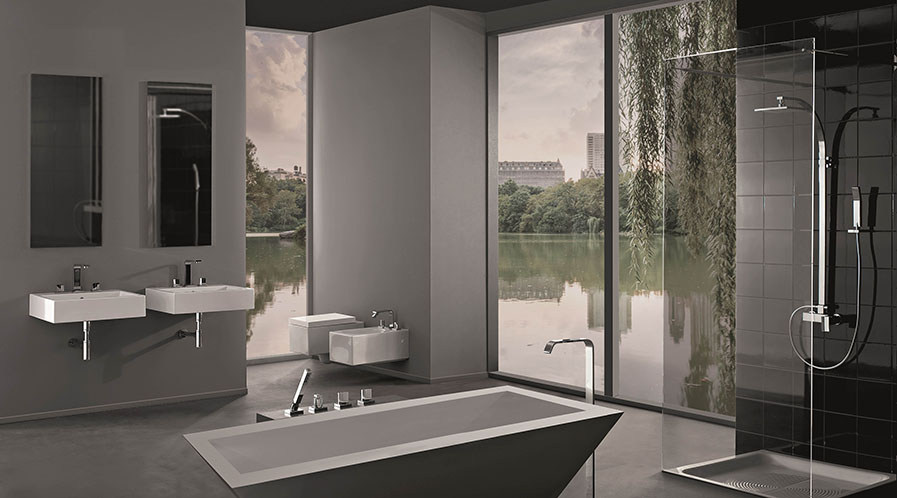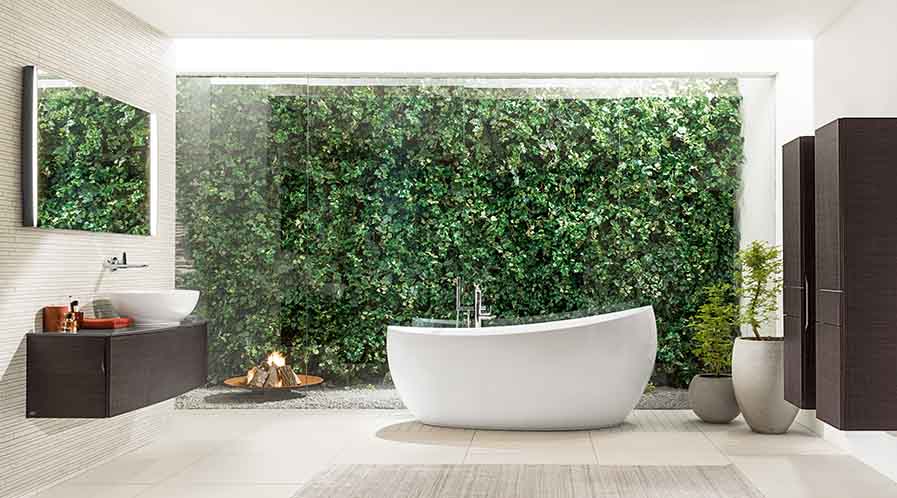Bringing the Outside Inside
Bringing in an element of nature inside washroom spaces, especially in the larger and luxury-oriented washrooms, is a trend that has really caught on, writes Soumadip Dey
The design of washroom spaces has been getting a lot of attention in the last few years. Designing the space as an extension of the bedroom or the adjoining spaces, increasing spending on aesthetics and the ambience of the washroom, turning the washroom into a private spa and embracing technology have been some of the noticeable trends. While on one hand, innovation is paving the way for the smart bathroom of the future, on the other hand, liberating the spaces by incorporating a rustic touch into the bathroom décor is also becoming popular among designers as well as users. Bringing in an element of nature inside washroom spaces is a trend that has really caught on.
There are many elements of nature that can be incorporated into washroom designs in lots of different ways to create spectacular washrooms. Most people like to relax in the bath and designing a nature-inspired bathroom often helps in setting the mood. Natural greenery promotes a sense of well-being, and there are several ways in which the look can be played out. For instance, a beautiful garden on the other side of the bathroom window will allow a person to enjoy the view right from the bathtub. If the property isn’t overlooked by neighbours, then an independent bathroom garden also becomes an option.

Trupti Doshi
Principal Architect, The Auroma Group
“One very important and obvious natural element to introduce in washroom design is the materials. Using wood, stone, earth or lime would be one way of bringing nature into the washroom.”
Bringing nature inside
Nature is part of human life. If we look back, the early man actually bathed in waterfalls or rivers where there was moving water, sky and wind. He experienced the elements of nature and these are the elements we try to incorporate when bringing nature into a washroom. “It can be done by including natural light, by landscaping and creating the movement of the wind. Nature can be made a part of the design by adding a garden area inside the washroom. Now, this is obviously not possible for a washroom where the space is limited. These kinds of designs work well with larger and luxury-oriented washrooms. Another option is making the shower area an extension of the bathroom that is open to the sky. This way, when someone takes a shower, they can see the sky and the opaque walls let them have more privacy than an outdoor shower,” opines Ponni M. Concessao, Principal Architect, Oscar & Ponni Architects.
For warmer climates, a small screened area just beyond the boundary to create a bathtime veranda in the open air can also help in bringing nature inside washroom design. Having a large window, that looks out onto a garden and lets the bathers soak up beauty while soaking in the tub can also have a similar effect. Speaking from experience, Anil Ranka, Principal Architect, Anil Ranka Architects says, “A project I am working on in Pune has a washroom of 500 square feet. With such a huge space, we have designed a Jacuzzi area that is open to the sky. When a person is taking a bath, they can enjoy the natural light and relax in nature. This is how nature can be incorporated. Outdoor showers and skylights are the best way to bring nature into washroom design. For luxury projects, a courtyard can be designed as part of a washroom and that can be considered as a garden, small plantation area or as a pebbled area.”
Pebbles can also be used in a myriad of ways including as a flooring option. They can cover the whole bathroom or only a portion of it, usually the area around the tub or in front of the sink. They can be used in combination with a stone tub to create a dramatic impact. Deepti Talpade, Urban Designer, CoDe Lab says, “Having gravels or pebbles in one part of the washroom gives a rustic touch to the overall design. It is also good to walk on and can be used to drain the water out.”

Using plants as natural element
However, it is not always possible to create such huge changes in bathroom design such as adding a bathtime veranda or miniature courtyard. Often changing some details can add a rustic touch to a bathroom, like installing a barn-style door, adding a sliding mechanism can make it practical and space-efficient on top of being really charming from an aesthetic point of view. Washroom designs that work around a natural concept often try to incorporate plants, sunshine, stones, wood or water as they are all related to nature elements.
Trupti Doshi, Principal Architect, The Auroma Group agrees, “One very important and obvious natural element to introduce in washroom design is the materials. Using wood, stone, earth or lime would be one way of bringing nature into the washroom. Another way is by adding plants inside the washroom. Having fragrant or plant with flowers will greatly improve the atmosphere and add the required greenery to make the washroom look natural.”

Deepti Talpade
Urban Designer, CoDe Lab
“Having gravels or pebbles in one part of the washroom gives a rustic touch to the overall design. It is also good to walk on and can be used to drain the water out.”
However, Trupti highlights a few key elements for incorporating plants in washroom design, “The plants should emit oxygen otherwise it defeats the purpose of having a plant so I would prefer live plants over artificial plants. There are some plants that emit oxygen 24 hours like Tulsi and it is always a good idea to include such plants. Today, even indoor vertical farming is being done using CFL light because it is close to natural sunlight. Indoor plants can easily be grown inside a washroom using such lights if natural light is limited.”
Deepti points out that washrooms in urban areas do not have an abundance of natural light and in these situations, the selection of plants has to be made wisely. She says, “The whole panel of the building skin or the facade can be kept very porous. Creeper plants can be used to enter the washroom from the facade. There are some plants that can thrive in low light especially creepers like bougainvillaea, Shevanti or Chrysanthemum or even spider plants. Incorporating these types of plants in the washroom design will bring a rustic theme even if there is not much natural light.”

The walls
Another major aspect that plays a big role in any design is the walls. A natural element like stone can also have a big impact on a washroom’s look as well as on the ambience inside the space. Instead of tiles, having an actual stone wall inside the space can completely change the feel and successfully create a rustic bathroom decor. A natural element that many designers prefer for the walls is wood – using live edge wood or reclaimed boards which emphasises the material’s natural beauty in a unique way. Installing wood boards on one of the bathroom’s walls helps in creating a rustic backdrop for the vanity and mirrors. But wood usually doesn’t work well in the shower area because of moisture issues. Both stone and wood are great materials to use in rustic bathrooms and make a great pair when it comes to creating an amazing washroom design. While stone can be used for the walls, wood makes an excellent choice for furniture.
Vertical gardens and living walls are often used to bring an element of nature inside the washroom. Instead of adding a few live plants, a living wall can more effortlessly create a natural feel, add life to a space and even conceal wall imperfections. Green walls are constructed with a skeletal structure that is hung with sections containing plants and flowers. It contains a large number of plants in a relatively small space thus providing maximum benefit. A living green wall works well in washrooms that don’t have extra space for home decor pieces. This way an element of nature can be incorporated into a washroom without using any shelf space, counter space or even floor space.

Anil Ranka
Principal Architect, Anil Ranka Architects
“A project I am working on in Pune has a washroom of 500 square feet. With such a huge space, we have designed a Jacuzzi area that is open to the sky. When a person is taking a bath, they can enjoy the natural light and relax in nature. This is how nature can be incorporated.”
Ceiling and skylight
An important aspect of washroom design that is sometimes overlooked is the ceiling. The right ceiling design can completely transform a washroom. The easiest way to incorporate natural elements into a washroom design is by adding a skylight because it brings natural light. Even in larger bathrooms, those already have big windows, or even glazed doors can still have a noticeable improvement with the addition of skylights. Unbroken glazed panels, which extend from one wall to another, are particularly effective especially if the light is allowed to bounce around the room.
While internal glazed partitions are good for allowing natural light, adding frosted ones in places where personal privacy is needed is a good option. Often washroom designs opt for a skylight that lines up with the bathtub directly beneath it. It is not always possible to install a large skylight that dominates the room in such cases using two smaller skylights can get good ventilation in the bathroom. If the washroom has a pitched roof, a classic design idea is double skylights that meet in the middle at the apex of the room. One advantage of a skylight is that more light means more with the textures on different surfaces. More subtle approaches to texture can be drawn out if there is enough light. But perhaps the biggest advantage why skylight helps in bringing nature into washroom design is the wide variety of plants that it allows being placed within the washroom.
However, it is not always possible to incorporate a skylight in the washroom design. “In such situations, having a mirror on top can achieve some of that natural effect,” adds Ponni. Trupti suggests a different approach when it comes to ceilings of nature-inspired washrooms, “The ceiling can be designed in a way to emulate natural sky. Designing a star-studded night sky with help of LED lights or a bright spring sky will definitely bring the natural feel inside the washroom.”
Box
Live Plants in the bathroom design
Including live plants in the washroom design can be tricky as all plants must conduct photosynthesis to survive. Often it is not possible to provide enough natural light to promote plant growth, especially in urban settings. While some plants need less light than others and hence choosing the right plants is important.
Plants hailing from rainforest settings do quite well in the high humidity, lowly lit environment. This makes them ideal for some washroom settings. Air plants (bromeliads) and some succulents can also do well in these circumstances. If natural light is scarce using artificial light can help. Replacing regular bulbs with full-spectrum bulbs can aid in photosynthesis. The bulbs can be placed close to the plants, this will provide bright light directly to the plant and create an attractive growth space. Apart from that, exposure to full-spectrum lighting is a proven mood elevator and is prescribed as a treatment for Seasonal Affective Disorder (SAD) which causes wintertime depression.
Here are some plants well suited to be used inside bathrooms:
Bamboo: it is an inexpensive and easy plant that grows in a low-light setting. It does not even need soil to grow and can be placed into a container of pebbles or marbles and filtered water.
Ferns: Ferns such as Birds Nest (Asplenium), Boston fern (Nephrolepis Exaltata) and Staghorn ferns do very well in low-light bathroom settings. They enjoy the humidity created from showers, but they also need regular watering and misting.
Cast Iron Plant: Aspidistra Elatior – the cast iron plant likes a low light setting and requires less watering. This attractive plant comes in both dwarf (18 inches) and full-size (2-3 feet high) varieties. Leaves may be dark green, yellow striped or dotted with yellow.
Chinese Evergreen: The Aglaonema is a lush, leafy plant with large leaves and is excellent for low-light bathrooms.
Dieffenbachia: Also known as the “Dumb Cane” is similar in appearance to Chinese Evergreen but it is much bigger. It needs bright artificial lighting to thrive.
Creating a natural atmosphere
Having at least one of these elements in the washroom design greatly increases its natural appeal. These elements are beneficial for people who use the washroom as a respite from their busy life and want to transform their bathroom into a personal refuge. According to Ponni, “One element that is often overlooked in such washroom designs is the sound. Adding the sound of crickets, birds, flowing water and other similar sounds can create a complete atmosphere. This when coupled with the right lighting and landscape will create a completely natural feel where the person will feel right in the middle of nature.” Bringing nature into the design by using these elements allows the inhabitants to enjoy a visual and acoustic experience during the bath. It also creates an atmosphere which makes them focus on nothing but themselves.
It’s important to use materials, finishes and colours in the right proportions when designing or decorating a space. Speaking from years of experience in washroom design, Ponni highlights the importance of innovative details and finishes. “When bringing nature into washrooms the tiles, colours, WCs and finishes have to be nature oriented. There are wooden wash basins and wooden WC, there are even moss-coloured tiles. If there is a patch of landscape in the bathroom with a skylight on top, the rest of the finishes will be sympathetic to the colours of the landscape. This way when anyone walks into the washroom, they will feel they are sitting amidst nature. There are tiles available in Europe and China called water tiles. Every time someone steps on it, the footprint gets embedded on the surface for some time and it gives the impression of walking on water.”

Ponni M. Concessao
Principal Architect, Oscar & Ponni Architects
“Nature can be made a part of the design by adding a garden area inside the washroom. Now, this is obviously not possible for a washroom where the space is limited. These kinds of designs work well with larger and luxury-oriented washrooms.”
Designing a washroom with natural elements comes with its own share of challenges. For instance, Ponni asserts that it is important to have a landscape consultant on board. “This is because many of the live plants often have a lifespan and they also require some form of maintenance. It is important to know what plants to use, what nutrients to give and the right soil composition, otherwise there would be bugs and worms in the washroom.”
Anil Ranka opines that it is the maintenance of the materials that is the biggest challenge in a nature-inspired washroom. “For instance, if water seeps in then maintaining the look can become difficult as it will lead to moss formation. This is particularly true for stone walls. This can be avoided by using tiles but then tiles do not have that natural feel of stone. The best way to avoid this is by incorporating a very well-designed drainage plan.”
Tags: Bathroom Design, Bathroom Interiors, Bathroom Products, Luxury Washrooms, Nature in Bathroom



